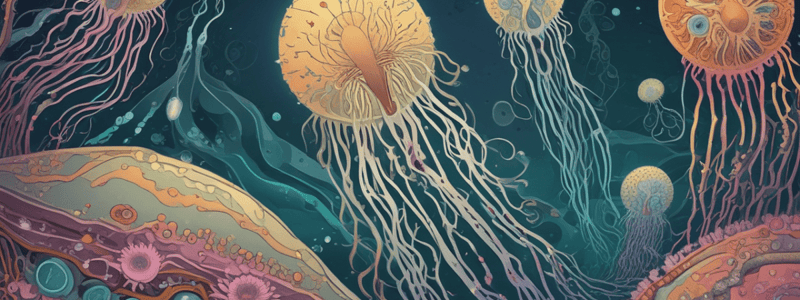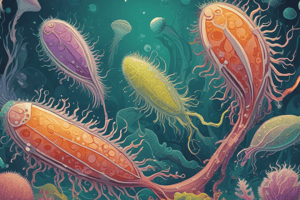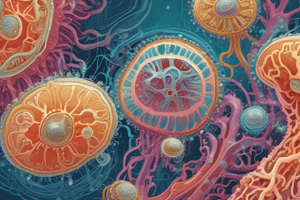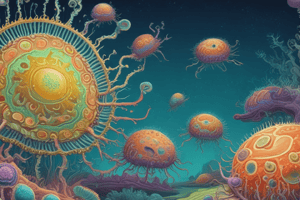Podcast
Questions and Answers
What is the distinguishing feature of Euglenozoa?
What is the distinguishing feature of Euglenozoa?
- The presence of a cell wall
- The presence of a single mitochondrion
- A spiral or crystalline rod of unknown function inside their flagella (correct)
- The ability to photosynthesize
Which group of organisms includes Trypanosoma gambiense, which causes sleeping sickness in humans?
Which group of organisms includes Trypanosoma gambiense, which causes sleeping sickness in humans?
- Apicomplexans
- Kinetoplastids (correct)
- Dinoflagellates
- Euglenids
What is the function of alveoli in Alveolata?
What is the function of alveoli in Alveolata?
- To synthesize proteins
- Unknown (correct)
- To provide structural support
- To aid in photosynthesis
Which of the following is NOT a characteristic of dinoflagellates?
Which of the following is NOT a characteristic of dinoflagellates?
What is the proposed endosymbiont of the SAR supergroup?
What is the proposed endosymbiont of the SAR supergroup?
Which group includes free-living consumers of prokaryotes in freshwater, marine, and moist terrestrial ecosystems?
Which group includes free-living consumers of prokaryotes in freshwater, marine, and moist terrestrial ecosystems?
What is the term for the organized mass of DNA found in kinetoplastids?
What is the term for the organized mass of DNA found in kinetoplastids?
Which of the following is an example of a disease-causing apicomplexan?
Which of the following is an example of a disease-causing apicomplexan?
What is the characteristic of the mitochondria found in Parabasalids?
What is the characteristic of the mitochondria found in Parabasalids?
Which of the following groups is thought to have evolved from endosymbiosis of an aerobic prokaryote?
Which of the following groups is thought to have evolved from endosymbiosis of an aerobic prokaryote?
What is the energy derivation mechanism used by Diplomonads?
What is the energy derivation mechanism used by Diplomonads?
Which group of protists includes the pathogen that causes yeast infections in human females?
Which group of protists includes the pathogen that causes yeast infections in human females?
What is the characteristic feature of the Diplomonad nuclei?
What is the characteristic feature of the Diplomonad nuclei?
Which group of protists is known for its feeding groove that appears like 'excavated' from the surface?
Which group of protists is known for its feeding groove that appears like 'excavated' from the surface?
What is unique about the apicomplexan's infectious cells?
What is unique about the apicomplexan's infectious cells?
Which protist group requires two or more different host species for completion of their life cycle?
Which protist group requires two or more different host species for completion of their life cycle?
What is the name of the parasite that causes malaria?
What is the name of the parasite that causes malaria?
What is the purpose of conjugation in ciliates?
What is the purpose of conjugation in ciliates?
What is characteristic of the flagellum of Stramenopiles?
What is characteristic of the flagellum of Stramenopiles?
What is the composition of diatomaceous earth?
What is the composition of diatomaceous earth?
What is the main mode of reproduction in diatoms?
What is the main mode of reproduction in diatoms?
Which of the following is NOT a subgroup of Stramenopiles?
Which of the following is NOT a subgroup of Stramenopiles?
What is a characteristic shared by all protists?
What is a characteristic shared by all protists?
What is the term for the process by which some eukaryotic cells engulfed bacteria, leading to the formation of organelles like mitochondria and chloroplasts?
What is the term for the process by which some eukaryotic cells engulfed bacteria, leading to the formation of organelles like mitochondria and chloroplasts?
What is the mode of nutrition where an organism can switch between autotrophic and heterotrophic modes of nutrition?
What is the mode of nutrition where an organism can switch between autotrophic and heterotrophic modes of nutrition?
What is the characteristic of some protists that exhibit alternation of generations, where two distinct generations are needed to complete a life cycle?
What is the characteristic of some protists that exhibit alternation of generations, where two distinct generations are needed to complete a life cycle?
What is the supergroup of protists that includes red or green algae?
What is the supergroup of protists that includes red or green algae?
What is the process by which a heterotrophic eukaryote consumed a cell with a chloroplast, leading to the formation of diverse chloroplasts in protists?
What is the process by which a heterotrophic eukaryote consumed a cell with a chloroplast, leading to the formation of diverse chloroplasts in protists?
What is the characteristic of most protists in terms of their cell structure?
What is the characteristic of most protists in terms of their cell structure?
What is the mode of nutrition where an organism produces its own food through photosynthesis?
What is the mode of nutrition where an organism produces its own food through photosynthesis?
What is the characteristic of the mitochondria found in Diplo Monads?
What is the characteristic of the mitochondria found in Diplo Monads?
Which group of exavates has a rod-shaped structure inside their flagella?
Which group of exavates has a rod-shaped structure inside their flagella?
What is the characteristic of the cytoskeletons of Exavates?
What is the characteristic of the cytoskeletons of Exavates?
Which subgroup of exavates eats the wall of the vaginal lining, causing symptoms?
Which subgroup of exavates eats the wall of the vaginal lining, causing symptoms?
What is the characteristic of the energy derivation mechanism used by Diplo Monads?
What is the characteristic of the energy derivation mechanism used by Diplo Monads?
Which group of exavates has a reduced number of mitochondria and are called hydrogenosomes?
Which group of exavates has a reduced number of mitochondria and are called hydrogenosomes?
What is the characteristic of the nuclei of Diplo Monads?
What is the characteristic of the nuclei of Diplo Monads?
Which group of exavates is known for its anaerobic mitochondria?
Which group of exavates is known for its anaerobic mitochondria?
What is the main function of the holdfast in brown algae?
What is the main function of the holdfast in brown algae?
What is the characteristic of the sporophyte generation in brown algae?
What is the characteristic of the sporophyte generation in brown algae?
What is the purpose of air bladders in some brown algae?
What is the purpose of air bladders in some brown algae?
What is the characteristic of the gametophyte generation in brown algae?
What is the characteristic of the gametophyte generation in brown algae?
What is the term for the process by which some brown algae undergoes meiosis to produce spores?
What is the term for the process by which some brown algae undergoes meiosis to produce spores?
What is the characteristic of the group Stramenopiles, to which brown algae belong?
What is the characteristic of the group Stramenopiles, to which brown algae belong?
What is the main pigment responsible for the red color of red algae?
What is the main pigment responsible for the red color of red algae?
What is the characteristic of some species of red algae?
What is the characteristic of some species of red algae?
What is the primary function of pseudopodia in Ryze area protists?
What is the primary function of pseudopodia in Ryze area protists?
What is the main component of the tests of Radialaria?
What is the main component of the tests of Radialaria?
What is the purpose of perforations in the tests of Foraminifera?
What is the purpose of perforations in the tests of Foraminifera?
What is the characteristic of Uniconta that distinguishes it from Ryze area protists?
What is the characteristic of Uniconta that distinguishes it from Ryze area protists?
What is the characteristic of slime molds that allows them to form a sporangium?
What is the characteristic of slime molds that allows them to form a sporangium?
What is the main difference between cellular slime molds and acellular slime molds?
What is the main difference between cellular slime molds and acellular slime molds?
What is the purpose of the spores in the life cycle of slime molds?
What is the purpose of the spores in the life cycle of slime molds?
What is the characteristic of Foraminifera that allows them to obtain sugar through photosynthesis?
What is the characteristic of Foraminifera that allows them to obtain sugar through photosynthesis?
Flashcards are hidden until you start studying
Study Notes
Euglenozoa
- Euglenozoa is a diverse clade that includes euglenids and kinetoplastids
- They have a spiral or crystalline rod of unknown function inside their flagella
- Euglenids have one or two flagella that emerge from a pocket at one end of the cell
- Kinetoplastids have a single mitochondrion with an organized mass of DNA called a kinetoplast
- They include free-living consumers of prokaryotes in freshwater, marine, and moist terrestrial ecosystems
Kinetoplastids
- Include Trypanosoma gambiense, which causes sleeping sickness in humans
- Another pathogenic trypanosome causes Chagas’ disease leading to congestive heart failure
SAR Supergroup
- Some data suggest that SAR is monophyletic and originated by a secondary endosymbiosis event
- The proposed endosymbiont is a red alga
- This clade is controversial and includes alveolates and stramenopiles
Alveolata
- Have membrane-bounded sacs (alveoli) just under the plasma membrane
- The function of the alveoli is unknown
- Include dinoflagellates, apicomplexans, and ciliates
Dinoflagellates
- Have two flagella and each cell is reinforced by cellulose plates
- Are abundant components of both marine and freshwater phytoplankton
- Are a diverse group of aquatic phototrophs, mixotrophs, and heterotrophs
- Toxic “red tides” are caused by dinoflagellate blooms
Endosymbiosis and Protist Evolution
- Endosymbiosis is the process in which a unicellular organism engulfs another cell, which becomes an endosymbiont and then organelle in the host cell
- Mitochondria are believed to have evolved by endosymbiosis of an aerobic prokaryote
- Plastids are believed to have evolved by endosymbiosis of a photosynthetic cyanobacterium
Diversity
- It is no longer thought that Excavates are the oldest lineage of eukaryotes
- Many have been shown to have mitochondria and have been reclassified
- Our understanding of the relationships among protist groups continues to change rapidly
- One hypothesis divides all eukaryotes (including protists) into four supergroups
Excavates
- Some members have a feeding groove that appears like “excavated” from the surface
- Include diplomonads, parabasalids, and euglenozoans
Diplomonads
- Have modified mitochondria called mitosomes
- Derive energy from anaerobic biochemical pathways
- Have two equal-sized nuclei and multiple flagella
- Are often parasites, for example, Giardia intestinalis (also known as Giardia lamblia)
Parabasalids
- Have reduced mitochondria called hydrogenosomes that generate some energy anaerobically
- Include Trichomonas vaginalis, the pathogen that causes yeast infections in human females
Apicomplexans
- Are parasites of animals, and some cause serious human diseases
- Spread through their host as infectious cells called sporozoites
- One end, the apex, contains a complex of organelles specialized for penetrating host cells and tissues
- Most have sexual and asexual stages that require two or more different host species for completion
Plasmodium
- Is the parasite that causes malaria
- Requires both mosquitoes and humans to complete its life cycle
- Approximately 900,000 people die each year from malaria
- Efforts are ongoing to develop vaccines that target this pathogen
Ciliates
- Are named for their use of cilia to move and feed
- Have large macronuclei and small micronuclei
- Genetic variation results from conjugation, in which two individuals exchange haploid micronuclei
- Conjugation is a sexual process, and is separate from reproduction, which generally occurs by binary fission
Stramenopila
- Include important phototrophs as well as several clades of heterotrophs
- Most have a “hairy” flagellum paired with a “smooth” flagellum
- Include diatoms, golden algae, brown algae, and oomycetes
Diatoms
- Are unicellular algae with a unique two-part, glass-like wall of hydrated silica
- Are a major component of phytoplankton and are highly diverse
- Fossilized diatom walls compose much of the sediments known as diatomaceous earth
- After a diatom population has bloomed, many dead individuals fall to the ocean floor undecomposed
- Reproduction is mainly asexual
Characteristics of Protists
- Protists are eukaryotic, meaning they have a nucleus and multiple membrane-bound organelles.
- They exhibit varied shapes, patterns, and organelles.
Historical Classification of Protists
- Protists were previously grouped into a single kingdom, but this was dismantled in the 1990s due to the lack of connection between organisms.
- Today, protists are classified into four supergroups: Excavata, SAR, Archaeplastida, and Chromalveolata.
Cell Structure and Nutrition
- Most protists are single-celled (unicellular), but some species form colonies or are multicellular.
- Protists have diverse subcellular structures, including organelles, which aid in survival.
- They can be photoautotrophs, heterotrophs, or mixotrophs, with varying modes of nutrition.
Modes of Nutrition
- Photoautotrophs use photosynthesis to produce energy, often with chloroplasts.
- Heterotrophs are unable to produce their own food and must ingest or absorb nutrients from their environment.
- Mixotrophs can switch between autotrophic and heterotrophic modes of nutrition.
Reproduction
- Some protists can reproduce asexually, while others use meiosis to produce nuclei for sexual reproduction.
- Some protists, like kelp, exhibit alternation of generations, where two distinct generations are needed to complete a life cycle.
Endosymbiosis
- Endosymbiosis is the process by which some eukaryotic cells engulfed bacteria, leading to the formation of organelles like mitochondria and chloroplasts.
- Primary endosymbiosis occurred when a heterotrophic eukaryote consumed a cyanobacterium, leading to the formation of red or green algae.
- Secondary endosymbiosis occurred when a heterotrophic eukaryote consumed a cell with a chloroplast, leading to the formation of diverse chloroplasts in protists.
Classification of Protists
- The four supergroups of protists (Excavata, SAR, Archaeplastida, and Chromalveolata) have distinct common ancestors and are believed to be polyphyletic.
- Each supergroup has unique characteristics that set them apart from others.
Protist Super Groups
- Protist classification is based on morphological and DNA data, and is subject to revision as new information becomes available.
Exavates
- Exavates are characterized by a unique groove on one side of their cytoskeleton, giving them an "excavated" appearance.
- They have modified mitochondria and two major groups with flagella that differ from other organisms.
Diplo Monads
- Diplo monads are a subgroup of exavates with modified mitochondria called microsomes, which lack an electron transport chain.
- They generate energy through anaerobic pathways and have two nuclei and multiple flagella.
- Many diplo monads are parasites, and an example is Giardia lamblia, which causes severe diarrhea and vomiting in humans.
Parasitic Diplomonads
- Giardia lamblia is a parasite found in stagnant water that can infect animals, especially dogs.
- It has an excavated side, modified mitochondria, and multiple flagella.
Parabasalids
- Parabasalids are a subgroup of exavates with a reduced number of mitochondria called hydrogenosomes, which are anaerobic and produce hydrogen gas as a byproduct.
- An example is Trichomonas vaginalis, a sexually transmitted disease that causes burning and itching sensations in women.
Parabasalids Characteristics
- Trichomonas vaginalis eats the wall of the vaginal lining, causing symptoms.
- It has an excavated side, multiple flagella, and other key characteristics of exavates.
Euglenoids
- Euglenoids are a subgroup of exavates with a rod-shaped structure inside their flagella and a kinetic plastid, a large mitochondrion with a large amount of DNA.
- They are free-living parasites, and an example is Trypanosoma, which causes African sleeping sickness and Jacques disease.
Euglenoids Characteristics
- Trypanosoma affects red blood cells, causing fever, fatigue, and an enlarged appearance.
- It has an undulated membrane, flagella, and an excavated side.
Neuglenoids
- Neuglenoids are a subgroup of exavates with a pocket at one end, from which one or two flagella emerge.
- They are mixotrophic, meaning they can undergo photosynthesis or ingest other organisms to gain energy.
- An example is Euglena, a typical microscopic organism found in pond water.
Neuglenoids Characteristics
- Euglena has a long, oval shape with a curved, excavated side.
- It has a pocket at one end, from which its flagella emerge.
Brown Algae
- Multicellular organisms that resemble plants in structure and function
- Consist of a holdfast that anchors them to rocks or substrate, but does not absorb nutrients like plant roots
- Have a stipe that resembles a stem and blades that contain photosynthetic cells
- Some species have air bladders that help them float upright and reach the surface of the water for more light
- Exhibit an alternation of generations, with sporophyte and gametophyte generations
- Sporophyte generation is diploid, produces spores through meiosis
- Gametophyte generation is haploid, produces gametes (eggs and sperm)
- Sporophyte generation produces spores that develop into gametophytes, and gametophyte generation produces gametes that fertilize to produce a new sporophyte generation
Life Cycle of Brown Algae
- Begins with fertilization, where a sperm fertilizes an egg to produce a zygote
- Zygote undergoes mitosis to produce a sporophyte, which grows and develops into a mature organism
- Sporophyte produces spores through meiosis, which develop into gametophytes
- Gametophytes produce gametes, which fertilize to produce a new sporophyte generation
Characteristics of Brown Algae
- Belong to the group Stramenopiles, characterized by having two flagella, one smooth and one hairy
- Capable of producing spores used for reproduction
Red Algae
- Multicellular organisms with an abundance of phycoerythrin, giving them a red color
- Can vary in color due to presence of other pigments
- Some species are edible and used in foods like sushi
- Typically found in marine environments
Green Algae
- Multicellular organisms found in both freshwater and marine environments
- Majority of algae living in freshwater, often filamentous
- Some species are flagellated and have a spherical shape, such as Volvox
- Important contributors to the food chain, providing energy for organisms like fish, snails, and sea urchins
Amoeboid Protists
- Amoeboid protists are not a monophyletic group and are classified into two different groups: Rhizaria and Uniconta.
- Rhizaria protists have thin, slender extensions called pseudopodia, used for locomotion and capturing prey.
Rhizaria
- Radialaria and Foraminifera are subgroups of Rhizaria.
- Radialaria have tests made of silica, with intricate and beautiful patterns and shapes.
- They have thin, slender pseudopodia for locomotion and capturing prey.
Foraminifera
- Foraminifera have tests made of calcium carbonate, a mineral abundant in seawater.
- They have thin, slender pseudopodia for locomotion and capturing prey.
- Their tests have perforations, small openings for the pseudopodia to move out and extend.
- Some Foraminifera have endosymbiotic algae that help them obtain sugar through photosynthesis.
Uniconta
- Uniconta is a clade that includes protists, animals, and fungi.
- It includes amoeboid protists, such as slime molds, that are not closely related to other protists.
Slime Molds
- Slime molds are a type of amoeboid protist, also known as acellular slime molds.
- They are composed of many cells with no plasma membrane dividing the cells.
- They have a mesh-like network of cytoplasm and nuclei.
- They form a sporangium when conditions become unfavorable, which releases spores through meiosis.
- The spores germinate into haploid amoeba cells.
Cellular Slime Molds
- Cellular slime molds are a type of amoeboid protist, different from acellular slime molds.
- They are composed of individual cells, each with its own nucleus and plasma membrane.
- They form multicellular aggregates and eventually form a fruiting body that produces spores.
- The solitary amoebas that emerge from the spores can engage in sexual reproduction or make aggregates.
Other Amoeboid Protists
- Tubulinians (formerly known as Gemmyna) are a type of amoeboid protist that move using cytoplasmic streaming.
- They are heterotrophic and feed on other protists, algae, and bacteria.
- Entamoeba histolytica is a type of amoeba that causes gastrointestinal disease, including amoebic dysentery, a leading cause of death in humans worldwide.
Studying That Suits You
Use AI to generate personalized quizzes and flashcards to suit your learning preferences.




